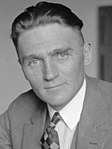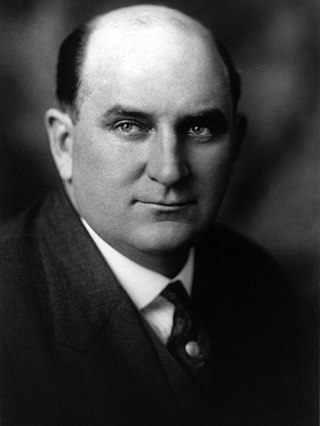
Lynn Joseph Frazier was an American educator and politician who served as the 12th Governor of North Dakota from 1917 until being recalled in 1921 and later served as a U.S. Senator from North Dakota from 1923 to 1941. He was the first American governor ever successfully recalled from office. The only other American governor to ever be recalled is Gray Davis, who was recalled in 2003.
The North Dakota Democratic–Nonpartisan League Party is the North Dakota affiliate of the national Democratic Party. It was formed as the outcome of a merger of two parties; the state previously had a three-party political system. It is one of only two state Democratic Party affiliates to have a different name from the central party, the other being the neighboring Minnesota Democratic–Farmer–Labor Party. The party currently has very weak electoral power in the state, controlling none of North Dakota's statewide or federal elected offices.

The 1926 United States Senate elections were elections for the United States Senate that occurred in the middle of Republican President Calvin Coolidge's second term. The 32 seats of Class 3 were contested in regular elections, and special elections were held to fill vacancies. The Republican majority was reduced by seven seats.

The 1944 United States Senate election in North Dakota took place on November 7, 1944. Incumbent Republican Senator Gerald Nye ran for re-election to his fourth term. He faced a serious challenge to his renomination in the Republican primary, with prominent Fargo attorney Lynn Stambaugh and Congressman Usher L. Burdick running against him. He won with one-third of the vote, defeating Shambaugh, his closest opponent, by fewer than 1,000 votes. In the general election, Stambaugh continued his campaign against Nye as an independent, splitting the Republican vote as Governor John Moses, the Democratic nominee, ran a strong campaign. Though Nye had benefited from crowded general elections before, he bled Republican support to Stambaugh and Moses unseated him with just 45% of the vote. However, just a few months into Moses's term, he died in office, flipping the seat back to Republican control and triggering a June 1946 special election.

The 1932 United States Senate election in North Dakota took place on November 8, 1932. Incumbent Republican Senator Gerald Nye ran for re-election to his second term. He was challenged in the Republican primary by Governor George F. Shafer, but easily won renomination. In the general election, he faced P. W. Lanier, a 1930 Democratic congressional candidate. Even as Democrats were performing well nationwide, Nye had little difficulty winning re-election in a landslide.

A general election was held in the U.S. state of North Dakota on November 4, 2014. Five of North Dakota's executive officers were up for election as well as the state's at-large seat in the United States House of Representatives. Primary elections were held on June 10, 2014.

The 1938 United States Senate election in North Dakota took place on November 8, 1938. Incumbent Republican Senator Gerald Nye ran for re-election to his third term. He faced a strong challenge in the Republican primary from colorful Governor William Langer, but narrowly won renomination. Langer subsequently ran as an independent against Nye in the general election, and won the endorsement of the Nonpartisan League. The contest effectively sidelined Democratic nominee J. J. Nygaard, and the contest between Nye and Langer devolved into sharp disagreements about the United States's foreign affairs. Nye ultimately defeated Langer by a wide margin—winning 50% of the vote to Langer's 43%—but significantly reduced from his 1932 and 1926 landslides.

The 1946 United States Senate special election in North Dakota took place on June 25, 1946. Democratic Senator John Moses, first elected in 1944, died on March 3, 1945, just two months into his term. Republican Governor Fred G. Aandahl appointed State Senator Milton Young to fill the vacancy and a special election was scheduled.

The 1950 United States Senate election in North Dakota took place on November 7, 1950. Incumbent Republican Senator Milton Young ran for re-election to a second term. In the Republican primary, he faced former Lieutenant Governor Thorstein H. Thoresen, who was endorsed by the Nonpartisan League. After winning the primary in a landslide, he faced State Senator Harry O'Brien, the Democratic nominee, in the general election. Aided by the national Republican landslide, Young defeated O'Brien in a landslide to win re-election.
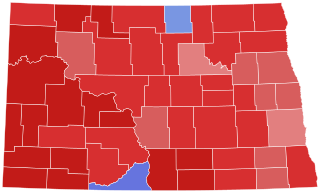
The 2020 North Dakota gubernatorial election was held on November 3, 2020, to elect the governor and lieutenant governor of North Dakota, concurrently with other federal and statewide elections, including the U.S. presidential election. Incumbent Republican governor Doug Burgum and lieutenant governor Brent Sanford were both re-elected to a second term.

North Dakota held two statewide elections in 2018: a primary election on Tuesday, June 12, and a general election on Tuesday, November 6. In addition, each township elected officers on Tuesday, March 20, and each school district held their elections on a date of their choosing between April 1 and June 30.

The 1920 United States Senate election in North Dakota took place on November 2, 1920. Incumbent Senator Republican Senator Asle Gronna ran for re-election to a third term. However, he was narrowly defeated in the Republican primary by Edwin F. Ladd, the President of the North Dakota Agricultural College, who had been endorsed by the Nonpartisan League. In the general election, Ladd was opposed by H. H. Perry, the Democratic nominee and a Democratic National Committeeman. As Republican presidential nominee Warren G. Harding overwhelmingly won North Dakota over Democratic nominee James M. Cox, Ladd also staked out a wide victory—though his margin of victory was not as large as Harding's.

The 1926 United States Senate election in North Dakota took place on November 2, 1926. Following his re-election in the special election earlier in the year, Senator Gerald Nye ran for re-election to a full term. Despite spurning the Republican Party's endorsement in the special election, Nye ran in the Republican primary in the regular election. On the same day that he defeated former Governor Louis B. Hanna in the special election—in which Hanna had the Republican nomination and Nye ran as the Nonpartisan League candidate—Nye defeated Hanna in the Republican primary for the regular election. Nye once again faced a crowded general election, but emerged victorious in a landslide, winning nearly 70% of the vote while none of his opponents exceeded 15%.
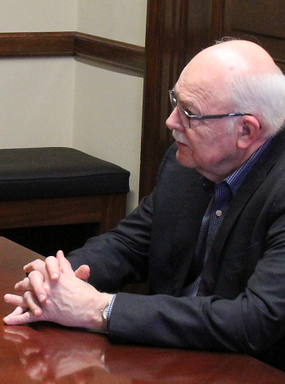
The 2018 North Dakota Secretary of State election occurred on November 6, 2018, to elect the North Dakota Secretary of State, concurrently with various other state and local elections. Six-time incumbent Republican Secretary of State Alvin Jaeger was eligible to run for re-election to a seventh term in office, but withdrew from his party's primary after failing to receive the endorsement. When the primary winner withdrew from the general election race, Jaeger and fellow Republican Michael Coachman each gathered and turned in signatures to run as independent candidates. Libertarian Party candidate Roland Riemers failed to get enough primary election votes to make the general election ballot both in an initial count and in a court-ordered recount. Democratic-NPL state representative Joshua Boschee was the only candidate who advanced from the primary and the only candidate that had his party listed on the general election ballot.

North Dakota held two statewide elections in 2020: a primary election on Tuesday, June 9, and a general election on Tuesday, November 3. In addition, each township elected officers on Tuesday, March 17, and each school district held their elections on a date of their choosing between April 1 and June 30.

The 1924 North Dakota gubernatorial election was held on November 4, 1924.
A general election was held in the U.S. state of Minnesota on November 3, 2020. All seats in the Minnesota Senate and Minnesota House of Representatives were up for election as well as several judicial seats, Minnesota's 10 presidential electors, a United States Senate seat, Minnesota's eight seats in the United States House of Representatives, and several positions for local offices. A primary election to nominate major party candidates and several judicial and local primary elections were held on August 11, 2020.

The 1918 South Dakota gubernatorial election was held on November 5, 1918. Incumbent Republican Governor Peter Norbeck ran for re-election to a second term. He won the Republican primary unopposed and faced Nonpartisan League candidate Mark P. Bates, a farmer, and Democratic nominee James E. Bird in the general election. Norbeck's share of the vote decreased from 1916 to 53%, but he benefited from the split field. Bates placed second with 26% of the vote, while Bird placed third with 19% of the vote.
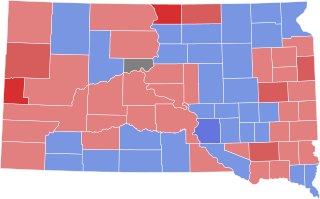
The 1938 United States Senate elections in South Dakota took place on November 8, 1938. Incumbent Republican Senator Peter Norbeck died in office on December 20, 1936. Herbert E. Hitchcock was appointed by Governor Tom Berry as Norbeck's replacement. Two elections for the same Senate seat were held on the same day; one as a special election to fill the remainder of Norbeck's six-year term, and another to select a Senator to serve the next six-year term.

The 2024 North Dakota gubernatorial election will be held on November 5, 2024, to elect the governor of North Dakota, concurrently with the U.S. presidential election, as well as various other federal, state, and local elections. Primary elections took place on June 11, 2024.


